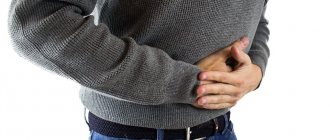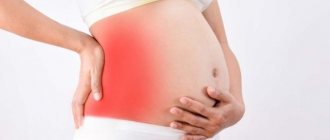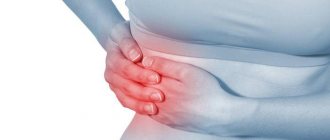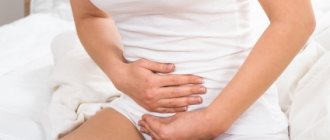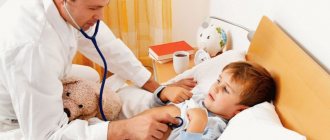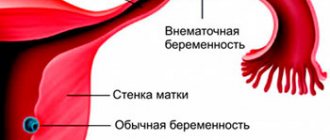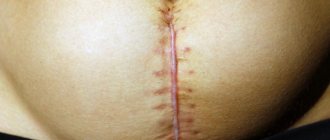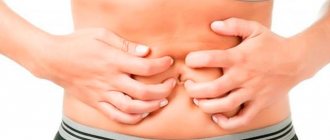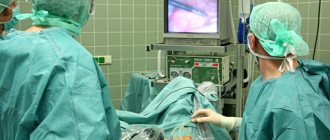Diagnostic aspects for pain in the right hypochondrium
The following are extremely informative for a doctor when making a diagnosis:
- nature of pain (intensity, recurrence, frequency of attacks, duration of episodes);
- its connection with food intake, movement, changes in body position, breathing intensity, time of day;
- nature of the pain (spastic, bursting, pressing);
- information about how the pain is relieved or then weakened;
- what phenomena accompany it (vomiting, heartburn, belching, sweating, fever);
- degree of intensity increase.
For example, a characteristic dull pain with a duodenal ulcer occurs 2-3 hours after eating, at night. Helicobacter pylori infection dramatically increases the likelihood of stomach and duodenal ulcers.
It is enough to simply answer the question why, in combination with these problems, along with pain in the right hypochondrium, side and chest, belching occurs. After all, it is one of the characteristic indicators that something is wrong with the internal organs, primarily the gastrointestinal tract. That is why it is so often a companion to the above problems.
But it even happens that there is no connection. For example, belching can occur when a person chews food poorly or is in a hurry to eat. And he can do this, as an option, precisely because pain prevents him from eating normally. Therefore, first of all, in most situations you need to deal with pain in the side, chest, and so on, and then the belching will disappear. And if it has not disappeared, then it is worth considering it as a completely separate problem.
With an increase in intragastric pressure, belching and sharp pain in the front of the epigastrium, in the right hypochondrium, may occur. Reasons for this:
- swallowing air during hasty eating;
- deep breaths through the mouth;
- frequent swallowing of saliva;
- hasty speech;
- smoking;
- abuse of soda and chewing gum.
Painful belching can occur due to the following factors:
- overeating;
- sudden movements and bending of the body forward immediately after eating;
- wearing tight belts that compress the stomach area.
Obese people often suffer from painful belching, but their discomfort is not associated with illness. “Shooting” in the right hypochondrium, belching of odorless air accompanies people who abuse strong coffee, tea, garlic, onions, and high-calorie foods. The symptom complex is accompanied by:
- people using inhalers;
- women during pregnancy due to compression of organs or before/during menstruation.
Pathological causes of pain under the right rib
Anatomically, the upper right quadrant of the abdomen includes: liver, gall bladder, part of the diaphragm and small intestine, duodenum, right kidney, pancreas.
Diseases and injuries of these organs can intensify the occurrence of pain in the right side under the ribs:
- The most obvious cause of pain is liver disease. This includes hepatitis, hepatosis and cirrhosis of the liver, parasitic lesions.
- Impaired patency of the biliary tract (cholecystitis). A sharp, acute pain that suddenly began, especially at night, is formed when the patency of the biliary tract is impaired and in acute cholecystitis. If the tone of the gallbladder increases, its tendency to contract increases, and the frequency and strength of its contractions also increases. Such processes are accompanied by sharp and short-term pain and are often provoked by nervous tension and stress.
- Urolithiasis disease. The cause of pain in the right hypochondrium may be urolithiasis, in which pain from the right kidney is felt acutely, but not clearly and can be felt in the back of the lower back, lower abdomen, as well as under the left or right side of the lower ribs. Urolithiasis is manifested by the detection of stones in the kidneys, bladder and urinary tract. There is a sharp pain that intensifies with every movement.
- Renal colic. It occurs when kidney stones begin to move and their sharp edges touch internal organs. The pain becomes very severe when the person moves. The stones block the urinary tract, causing the pain to shift to the groin.
- Peptic ulcer disease. Characteristic pain in the right hypochondrium anteriorly accompanies gastric and duodenal ulcers. The nature of the pain and its intensity depends on many factors. Discomfort occurs after eating, on an empty stomach or after exercise. The pain syndrome is accompanied by heartburn, sour belching, vomiting, loss of strength, alternating diarrhea and constipation, and rapid heartbeat. Often, peptic ulcer disease occurs in a latent form; in advanced cases, there is a threat of internal bleeding and peritonitis, which poses a danger to the patient’s life and requires urgent surgical intervention.
- Biliary dyskinesia is a violation of the motor function of the organ. The main reasons for the development of the disease are stress, poor diet, and heavy physical activity. Usually, when examined for dyskinesia, the patient is diagnosed with diseases of the digestive system. The pathology occurs spontaneously, accompanied by heaviness, paroxysmal acute pain in the right side, nausea, stool upset (diarrhea or constipation), tachycardia, the appearance of a bitter taste in the mouth, and in rare cases, headache. Dyskinesia is accompanied by stagnation of bile in the gallbladder, which contributes to the formation of stones and the development of cholelithiasis.
- Pancreatitis. Throbbing pain indicates pancreatitis. The exact cause of inflammation of the pancreas has not been established. The pathology begins with throbbing, intense, girdling pain. If these symptoms occur, the patient requires immediate hospitalization and emergency surgical treatment. Pronounced pain in the right quadrant of the abdomen is observed during the transition of pancreatitis from the acute to the chronic stage and can be treated conservatively.
- Intercostal neuralgia. Pain in the hypochondrium is not always caused by pathology of the internal organs. Thus, pain in the rib area can occur due to skeletal diseases. Such a common disease as osteochondrosis occurs with degeneration of spinal cartilage. The altered cartilage puts pressure on the nerves, which leads to pain.
https://youtu.be/QXolRE95wdo
The one on the right...
The liver, gall bladder, part of the large intestine, the right part of the diaphragm, and the lower lobe of the right lung are projected into the right hypochondrium. Diseases or injuries of the listed organs can cause pain on the right side of the peritoneum, the nature and manifestations of which depend on the consequences that arise.
Causes of pain in the hypochondrium on the right, not related to the functioning of the digestive tract, may include:
- right-sided inflammation of the so-called pariental peritoneum, lining the abdominal cavity from the inside;
- preeclampsia (in pregnant women) as a result of generalized vascular damage;
- hemorrhage under the liver capsule, its abscess;
- pneumonia;
- myocardial infarction;
- right-sided pyelonephritis;
- myocardial infarction, right ventricular failure.
Intermittent pain in the right hypochondrium is sometimes a consequence of vegetative-vascular dystonia. A cough combined with pain in the right side may be a sign of right lower lobe pneumonia caused by pneumococci. Currently, her outpatient treatment is possible.
During physical activity
Absolutely healthy people may complain of pain in the right side of the abdomen and belching if, in the absence of training, they undertake hard work or begin to engage in intensive sports.
The pathogenesis is that with the active release of adrenaline into the blood, the tone of the bile ducts (bile ducts) decreases, which provokes stagnation of bile. Against the backdrop of increased pressure in the gallbladder, valves begin to operate, separating the duodenum and stomach. Bile backflows into the stomach and further into the esophagus, which causes belching with a bitter aftertaste.
- start physical activity (bending, lifting weights) immediately after eating;
- start running long distances without breathing preparation.
Causes of exacerbations
Pain in the right side can cause sudden exacerbations of chronic diseases, the “trigger” for which are:
- loss of strength associated with decreased immunity;
- overwork, physical and emotional overload;
- changes in the hormonal status of the body (pregnancy, hormonal and radiation therapy, surgery), affecting the qualitative and quantitative production of digestive enzymes;
- seasonal disruptions of the body’s biological “clock” associated with fluctuations in temperature and atmospheric pressure, changes in the length of daylight hours.
During the off-season, you should strictly adhere to the regimen of taking prescribed medications.
Ways to restore the liver
Drug treatment includes the prescription of hepatoprotectors - a type of drug that restores liver cells and has a beneficial effect on the functioning of the organ. In addition, medications may be prescribed to suppress nausea and vomiting. Physiotherapy and dosed physical therapy are used in the treatment of liver diseases.
Among folk remedies, a decoction of oats is useful, as well as all kinds of herbal infusions.
Norman Walker's method is gaining popularity, in which you need to drink freshly squeezed vegetable juices every day. Preferably at least one liter per day.
If you have a diseased liver, you should follow a diet that excludes fatty and fried foods; bread and other baked goods; vegetables and fruits that cause bloating; spicy dishes; sweets; alcoholic drinks.
Eating the following foods is beneficial:
- Various cereals;
- Fish;
- Milk, fermented milk products: kefir, cottage cheese;
- Lean meat: rabbit, turkey. Including soups made from them.
If liver function is not restored by the above methods, surgical intervention involving organ transplantation is required.
Pregnancy
There are many reasons for the appearance of pain in the right hypochondrium with a radius to the side and belching of air during pregnancy. The most basic:
- Stretching of the uterus in the second trimester. The organ begins to put pressure on the gastrointestinal tract, displacing its sections upward. Kinks in the gallbladder and gallbladder begin to form. Bile is unevenly distributed and stagnates in the bladder. Pain, flatulence appear, digestion is disturbed, which is accompanied by belching.
- Exacerbation of existing gastrointestinal pathologies.
- There is a heavy load on the liver, which needs to work twice as hard due to the increased volume of blood needed to supply the organs of the mother and the growing baby with the placenta.
- Increasing the concentration of the hormone progesterone, which is responsible for muscle relaxation, as a way to prepare the mother’s body for the upcoming birth. The sphincters do not close tightly, and constant gastroesophageal reflux occurs with irritation of the mucous membranes of the duodenum, stomach, and esophagus. Belching and colic appear in the area of the right hypochondrium.
Pain relief
Pain in the internal organs, which are located in the area of the right hypochondrium, may mean a short-term disruption of their function (spasm), a chronic disease (hepatitis, cholecystitis, colitis, etc.) or a rapidly developing pathology (appendicitis). Pain receptors react to irritation of the organ mucosa, swelling and stretching of tissues, and violation of their integrity.
Sometimes pain in the right hypochondrium occurs in healthy people as a result of physical activity, before menstruation in women. If during physical effort, when inhaling or when coughing there is pain on the right side under the ribs, there is a high probability that it may be cholelithiasis or kidney stones. The load causes the movement of stones, which becomes a possible cause of pain in the right hypochondrium in front.
The first thought of many people when there is pain under the right rib is to take any painkiller or antispasmodic. However, this can blur the clinical picture - create a short-term illusion of recovery, although in fact the disease continues to progress. That is why it is better to first undergo a full diagnosis - the causes of pain in the right hypochondrium under the ribs can be very different.
If there is pain on the right under the ribs due to a violation of the outflow of bile, a heating pad on the area of the right hypochondrium (if there are no stones in the bladder) can help relieve pain at home. Choleretic drugs and antispasmodics relieve an attack. For cholelithiasis in advanced cases, surgery is performed to remove the bladder.
Liver diseases usually require long-term and continuous treatment. To relieve discomfort, antispasmodic tablets and drugs that stimulate bile production are used. For liver and intestinal diseases, stomach diseases, it is important to follow the diet prescribed by your doctor. It is necessary to take antiparasitic drugs only when Giardia is detected - this should not be done for prevention, since all such tablets are highly toxic.
Provocateurs of the digestive system
Discomfort and any pain in the right hypochondrium, especially in combination with heartburn, is a clear and characteristic symptom of diseases of the digestive system, such as:
- ulcerative colitis, inflammation of the colon (especially its segment adjacent to the omental bursa), obstruction of the large intestine;
- cholelithiasis, cholecystitis;
- dyskinesia of the bile ducts and spasm of the sphincter of Oddi - the “exit gate” of the biliary tract;
- inflammation or ulcer of the duodenum, stomach;
- inflammation of the pancreas;
- acute appedicitis.
Treatment
Before starting therapy, it is necessary to know exactly the cause of the symptoms, since in acute conditions surgical intervention may be necessary, and in the case of an intestinal infection, antibacterial treatment.
We will describe symptomatic treatment and folk remedies that can bring temporary relief. Their use without prior consultation with a specialist is not advisable and is permissible only in the case of a one-time and not particularly pronounced appearance of symptoms.
The combination of diarrhea and pain in the right hypochondrium is not a specific symptom of a particular disease, therefore only a doctor can prescribe adequate treatment after a preliminary examination and examination data.
Restoration of water-electrolyte balance
To replenish water and mineral solutions lost with diarrhea, use the drug Regidron. He contains:
- Sodium ions
- Calcium ions
- Chlorine ions
- Glucose
These substances maintain balance in the body and help maintain the required level of fluid in blood vessels and tissues.
To take, use 1 sachet, which is diluted in 1 liter of water and drunk in small sips throughout the day. If vomiting is added to the symptoms, the drug should be given 10 minutes after it stops.
You can also use drugs:
- Gastrolit
- Glucosolan
- Orasan
- Reosolan
- Citroglucosolan
A similar drink can be prepared at home. To do this, add 3 g of table salt and 15 g of sugar per liter of boiled water, mix thoroughly until completely dissolved.
Sorbents
To stop diarrhea, sorbents are often used - they bind substances on their surface and remove excess fluid and toxins from the body. Drugs in this group have different release forms, each of which has different features of use.
Sorbents are prescribed with caution to children, as they can negatively affect intestinal motility and cause constipation.
Use:
- Sorbex
- Activated carbon
- Smecta
- Atoxyl
- Polysorb
Of all the sorbents, Smecta has the largest number of indications; it is also approved for use even by pregnant women. Use 1 packet (3 g) three times a day, diluted in half a glass of water.
Antispasmodics
The painful symptom of diarrhea often occurs due to spasm of the smooth muscles of the digestive organs. A number of drugs have a relaxing effect and reduce discomfort.
The most common antispasmodics include:
- Drotaverine
- No-shpu
- Papaverine
- Papazole
- Spasmol
Many plants also have an antispasmodic effect, for example:
- Chamomile
- Cumin fruits
- Tansy
- Mint
- Lily of the valley
- Belladonna
They can be added to tea, or prepared decoctions and infusions. Mint and chamomile have the least number of contraindications. They are poured with 500 ml of boiling water per 1.5 tablespoons of dried herbs. Drink half a glass on an empty stomach. This not only reduces pain, but also relieves the inflammatory syndrome somewhat.
Folk remedies
Traditional methods can help relieve or reduce symptoms if it is not possible to urgently visit a doctor.
Here are examples of recipes that will help eliminate pain from diarrhea:
- Rice is thrown into boiling water in a ratio of 1 to 2 and cooked until a viscous consistency is obtained. Add starch (1 teaspoon), diluted in ½ cup of cold boiled water. Then the mixture must be stirred well and drunk in one go.
- Pour a glass of boiling water onto 100 g of burnet, cook for another 30 minutes, and then filter. Take 4-6 times a day, 1 tablespoon of decoction diluted in ¼ glass of water. The plant is effective not only due to its astringent properties, but also due to its strong bactericidal effect.
- Three tablespoons of chopped branches of young rose hips should be poured into 0.5 liters of water, boiled over low heat for 10 minutes, left for another 1 hour, and then strained through several layers of gauze. Take 2 tablespoons 3-4 times a day before meals for diarrhea and other dyspeptic symptoms.
- Rosehip root (pre-crushed) is poured with 2 glasses of water, boiled over low heat for 10 minutes, left for 1 hour, strain. Drink the resulting liquid 100 ml 3-4 times a day.
You should not use these remedies after diarrhea has stopped, as highly astringent substances in overdose can cause constipation.
Diet
Since a number of diseases can be behind diarrhea and pain in the right hypochondrium, several treatment tables are used to maintain normal digestion:
- Diet No. 2 – used for intestinal diseases (colitis and enteritis) during exacerbations, helps reduce symptoms
- Diet No. 4 - eliminates stool disorders and normalizes the tone of the intestinal muscles during exacerbation of diseases accompanied by diarrhea.
- Diet No. 5 – necessary for diseases of the liver or biliary tract, such as hepatitis, cholecystitis and others.
- Diet No. 5b - used for chronic pancreatitis, to normalize the production of enzymes and digestion of food.
When several diseases occur, a combination of diets is used. Since the symptoms of diarrhea often come first, the recommendations of table No. 4 are added to any diet.
Prohibited:
- Baking
- Pickles
- Marinades
- Canned food
- Cold drinks
- Ice cream
- Millet
- Barley grits
- Coffee with milk
- Mushrooms
- Sausage
- Legumes
When the exacerbation of diarrhea passes, the general principles of the diet should not change. When returning to an active lifestyle, the usual diet is introduced gradually.
Stomach and duodenum
Belching with pain is accompanied by pathologies such as:
- Gastritis, which is characterized by: dull, non-intense, short-term, periodic pain attacks on the right side, under the ribs, in the sternum, appearing 1.5 hours after a meal and on an empty stomach;
- loss of appetite;
- belching with a sour aftertaste;
- constipation or diarrhea.
- Duodenitis, which manifests itself as: aching pain in the right upper epigastrium, radiating to the back, scapula, with or without girdling, occurring 2 hours after eating;
- vomiting;
- heartburn, bitter regurgitation;
- weakness, sweating;
- diarrhea.
- Ulcer of the duodenum, manifested by: aching and prolonged or stabbing and cramping pain in the right sector and above in the epigastrium;
- burning and belching;
- nausea with vomiting;
- constipation
Diagnostics
If the right side is very painful, and diarrhea accompanies the unpleasant condition, a specialist, after a visual examination and questioning of the patient, may prescribe:
- Analysis of urine and vomit.
- Coprogram.
- General and biochemical blood testing.
- Endoscopy, fluoroscopy.
- Ultrasound and CT.
- Duodenal sounding.
find me
| Radiation of pain under the right rib | Alleged cause |
| In the neck, right shoulder with transition to the collarbone, right eyelid and brow ridge | Exacerbation of cholecystitis, hepatic colic |
| In the lower third of the abdomen | Acute appendicitis, gynecological pain |
| Acute twisting pain of uncertain localization, subsiding after defecation, loose stools | Irritable bowel syndrome |
| Liquid bloody stools coupled with acute pain throughout the peritoneum | Ulcerative colitis, Crohn's disease |
| Dull pain radiating to the back | Chronic course of cholecystitis, pyelonephritis, urolithiasis |
The causes of unbearable severe pain that require immediate medical attention are:
- gallbladder rupture;
- rupture of the fallopian tube or ovarian cyst;
- acute pyelonephritis;
- opisthorchiasis;
- hepatic colic.
In such situations, it is necessary to stay with the patient until the ambulance arrives.
Starring
Signs of liver pathology with unclear pain in the right hypochondrium:
- their obvious connection with dietary disorders (primarily the consumption of fatty foods);
- characteristic irradiation of pain;
- itching of the skin in a limited area;
- weakness and fatigue, bitterness in the mouth;
- yellow coating on the tongue, dark urine, light-colored stool;
- heartburn and bitter belching.
The liver filters the blood, being in the path of its flow, from toxic metabolic products, toxins formed in the body, foreign substances coming from the digestive tract along its entire length. The liver continuously produces bile, without which digestion and absorption of nutrients would be impossible. That is why the slightest interruptions in the production of bile or its timely entry into the duodenum have enormous consequences for the functioning of the gastrointestinal tract. Along with the spleen and bone marrow, the liver is involved in the body's immune responses.
All this determines the enormous importance of the liver both under physiological conditions and in liver pathologies of an inflammatory (hepatitis) and dystrophic (hepatosis) nature.
Liver and gallbladder
- Inflammation of the gallbladder, manifested by: prolonged pain;
- belching with a bitter taste;
- nausea with vomiting.
- Hepatitis. Acute/chronic inflammation of the liver, provoked by viruses, alcohol abuse, autoimmune pathologies, intoxication, is accompanied by: icteric pallor;
- general weakness;
- subfibrality;
- weight loss due to refusal to eat;
- itching on the skin;
- colic in the right upper epigastrium;
- bitter belching.
- GSD, when stones form in the gallbladder and/or ducts. The disease is characterized by: dull, aching pain in the right shoulder blade, shoulder;
- increased symptoms due to severe anxiety, malnutrition, shaking, and changes in weather conditions;
- periodic attacks of biliary colic with strong, cutting sensations;
- nausea, vomiting, belching with a bitter aftertaste.
- Dyskinesia of the gallbladder, when the flow of bile in the duodenum is disrupted. There are two types of the disease with different symptoms: hypotension, when there is aching, constant pain and heaviness in the hypochondrium, bloating that develops 60 minutes after eating, nausea, belching, weakness;
- hypertension, when severe, stabbing, paroxysmal pain appears in the right side under the ribs and near the navel, appearing 30 minutes after eating and accompanied by belching.
The main causes of belching and pain in the hypochondrium
Gilbert's disease
What are the causes of bitterness in the mouth and belching? These symptoms are characteristic of such a rare disease as Gilbert's syndrome. This term hides a pathology that is characterized by episodes of jaundice due to an increase in the level of indirect bilirubin in the blood.
In Gilbert's disease, in addition to jaundice syndrome, dyspeptic disorders are also observed. After eating food, the patient experiences heartburn, nausea, vomiting, bitter taste in the mouth, burning sensation in the mouth, and flatulence.
Gilbert's disease is also characteristic of:
- Increased fatigue.
- High body temperature.
- Drowsiness or insomnia.
- The appearance of age spots on the face and body.
- Heaviness in the right hypochondrium combined with colic.
- Swelling of the limbs.
- Pain in the epigastric region.
Hepatitis
When considering the question of why, after eating, a person may experience pain in the hypochondrium, belching and a bitter taste in the mouth, hepatitis should be mentioned. This pathology is characterized by an acute or chronic inflammatory process in the liver.
Hepatitis mainly develops due to the penetration of viral agents. Pathogenic microorganisms first enter the blood, and then penetrate the liver through the portal vein and become embedded in hepatocytes. There are viral hepatitis A, B, C, D, E, F, G.
There are also autoimmune, drug and alcohol forms of the disease. From the names you can understand the etiology of the inflammatory process. In addition to bitterness in the mouth, nagging pain in the hypochondrium and belching air, with hepatitis a person complains of:
- Asthenic syndrome.
- Increased body temperature (increases to subfebrile values).
- Pain in joints and muscles.
- General weakness.
- Changes in skin color and eye whites. Viral hepatitis C and B can be anicteric.
- Colic in the right hypochondrium.
- Dyspeptic disorders.
With viral forms of hepatitis, even headaches and dizziness may occur. According to some reports, viruses can penetrate through the blood into the brain, as a result of which a person experiences asthenia in combination with migraine.
Cirrhosis
Cirrhosis is an advanced stage of fibrosis. The pathology is characterized by the degeneration of parenchymal tissue into fibrous connective tissue. With cirrhosis, the pressure in the portal vein system increases, portal hypertension and ascites are observed.
The disease is asymptomatic in 20% of cases. But much more often there are signs. Thus, the patient complains of dyspeptic disorders, aching or sharp pain in the right hypochondrium, and jaundice syndrome.
Cirrhosis also manifests itself:
- "Drumstick syndrome." The patient has thickening of the phalanges of the fingers.
- “Watch glasses” - a modification of the nail plates.
- Palmar erythema. The skin of the palms of a person turns red, he experiences local hyperemia, burning, and itching. A rash and even pustules may appear on the skin.
- Spider veins. This definition refers to the protrusion of blood vessels on the face, body, abdomen, and legs.
- Increased bleeding of gums.
- Varicose veins of the esophagus and rectum.
- Bitter taste in the mouth.
- “Bitter” belching, burning in the mouth.
Cholecystitis
Cholecystitis is an inflammatory process in the gallbladder. There are two types of disease - stone and stoneless. In the first case, cholesterol or bilirubin stones form in the gallbladder. The stoneless form is less common.
Due to the inflammatory process in the gallbladder, the functionality of the digestive system as a whole is disrupted. As a result, a person often burps something bitter, experiences an unpleasant taste in the mouth, and complains of chronic diarrhea, flatulence, and bloating.
Cholecystitis is also accompanied by:
- Biliary colic.
- Pain in the hypochondrium, which can radiate to the shoulder blades, lower abdomen, and chest.
- Vomiting and nausea. Black impurities may appear in the vomit.
- Chills, elevated body temperature.
- Jaundice. It develops due to a violation of the outflow of bile and the entry of indirect bilirubin into the blood.
Biliary dyskinesia
Biliary dyskinesia is a pathology accompanied by impaired motility. The main causes of ADHD are autonomic dysfunction, liver disease, and acute calculous cholecystitis.
Biliary dyskinesia may be completely asymptomatic in the early stages. But over time, after eating, drinking alcohol and intense physical activity, a person begins to experience heaviness in the stomach.
In addition, JVP manifests itself:
- Bitter taste in the mouth.
- Hepatomegaly.
- Pain on palpation of the gallbladder and liver.
- Bad breath.
- Nausea and vomiting.
- Increased body temperature.
Bile factor
Bile has bactericidal properties and is a powerful catalyst for pancreatic enzymes. Changes in its composition and (or) quantity radically affect the intensity and quality of digestion.
The main bile duct and the pancreatic duct open at almost the same point in the duodenum. Therefore, when a stone blocks the bile duct, inflammation of the pancreas develops up to pancreatic necrosis. Not only pain in the liver area appears, but also sharp girdling pains characteristic of acute pancreatitis.
Consequences of the “rockfall”
The formation of stones is provoked by rare meals and stagnation in the biliary system. Prevention of bile stagnation - eating at least 5 times a day, consuming foods rich in dietary fiber.
Sometimes the presence of stones does not cause any significant symptoms, but stone formation in most cases has dangerous, far-reaching consequences, and they are as follows:
- attacks of stabbing pain with characteristic irradiation (in combination with cholecystitis) as a result of spastic contractions of the biliary tract, so-called colic;
- temperature increase;
- complete blockage of the ducts.
Paroxysmal severe pain occurs in diseases of the biliary tract as a result of a violation of the outflow of bile and an increase in pressure in their lumen. Pinching of a stone in the neck of the bladder makes the pain unbearable. Blockage of the bile ducts causes jaundice, which may appear or disappear depending on how the stone is oriented, what its shape is and how much it blocks the lumen of the bile duct.
Heartburn is a sudden release of liquid food gruel back into the esophagus. This phenomenon is called reflux and becomes possible when the pressure in the stomach cavity becomes higher than in the esophageal tube. A burning sensation occurs when the esophageal mucosa is irritated, and prolonged irritation increases both pain and the degree of trauma to the esophagus, up to ulceration.
Violations of the biliary function of the liver cause a general disorder of gastric and intestinal digestion due to a deficiency of bile at the time food enters the duodenum. Food mass accumulates in the small intestine, causing its overload, intoxication, fermentation and putrefaction processes, accompanied by the separation of gases and an increase in pressure inside the peritoneum. The overcrowded intestines begin to “prop up” the stomach from below, changing its position and unclenching the valve through which food enters.
Congestion in the stomach and small intestine, coupled with increased peritoneal pressure, leads to the reverse movement of first accumulated gases (gas reflux or belching), and then liquid contents, causing heartburn.
Pain in the liver in combination with heartburn indicates persistent disturbances in the motility of the upper gastrointestinal tract and pathologies of bile secretion. The nature of these pains and accompanying symptoms, coupled with a clinical examination, will allow an accurate diagnosis and a therapeutic approach to be determined.
Rate this post
Nutrition, folk remedies and exercises
If you have intestinal disorders, it is important to follow a gentle diet. Acute pain prevents eating. Severe poisoning and intestinal infections require fasting on the first day. It is necessary to drink enough clean water and take medications to normalize your health. On the second day the patient begins to eat. The best food is stewed vegetables, slimy porridges, mashed potatoes, boiled lean meat, baked apples. These dishes replenish the lack of vitamins and restore the intestinal and stomach mucosa.
In addition to diet, traditional medicine will help improve the patient’s condition:
- Dill. Painful sensations in the abdomen are often associated with increased gas formation and intestinal colic. Dill seeds are used as a carminative. To get rid of flatulence and relieve spasms, you need to brew them with boiling water and leave for 40 minutes. Then the infusion is filtered and drunk in small portions throughout the day.
- Melissa. This herb is used for many gastrointestinal diseases. Decoctions are recommended for diarrhea, intestinal spasms and pain. To prepare the medicine, take 4 tablespoons of lemon balm and pour boiling water over it. After 20 minutes, you can drink the infusion one tablespoon three times a day.
- Oak bark. It contains tannins and helps even with prolonged and severe diarrhea. The bark is boiled for 10 minutes, then cooled, filtered and taken by mouth 3 times a day.
- Black tea with mint. Mint perfectly relieves inflammation and relieves flatulence, and black tea has an astringent effect. It is brewed stronger than usual, adding a couple of sprigs of mint. You can drink it throughout the day like regular tea.
There is also some exercise against diarrhea. However, for severe abdominal pain and weakness, bed rest is recommended. These exercises are not intended for acute periods. They can be performed when the patient feels better or during remissions of chronic diarrhea. Most exercises are performed lying down. For example, spreading straight legs to the sides, alternating leg lifts, and “bicycle” are considered effective. Physical education helps normalize blood circulation in the pelvic organs, improve overall well-being and intestinal function.
Intestines
- Appendicitis. The initial stage of inflammation of the duodenum is manifested by acute pain on the right with a gradual descent into the peri-umbilical, then into the iliac zone. At the same time there is: fever;
- severe nausea, vomiting;
- weakness;
- refusal to eat.
- Enteritis. With inflammation of the mucous membrane of the small intestine, the pain syndrome spreads below, to the right of the abdomen. Paroxysmal pain occurs along with rumbling in the abdomen, diarrhea, bloating, and regurgitation.
- An inguinal hernia is characterized by acute colic on the right and in the groin, radiating to the leg. The sensations intensify with physical activity and heavy lifting. A protrusion may appear in the right side, which disappears while lying on your back.
Dangerous inflammatory diseases - appendicitis and peritonitis
With appendicitis, intestinal disorder is rarely diagnosed, especially in adults, although in children the symptom is observed in most cases. Diarrhea and pain occur due to inflammation, which causes infection and harmful microorganisms - staphylococci and E. coli - to appear in the gastrointestinal tract. A peculiarity of damage to the appendix of the cecum in children and adolescents is the appearance of diarrhea, after which pain occurs (temporarily decreases when turning to the right), intensifying and continuing subsequently.
Symptoms of appendicitis
- nagging, bursting pain (initial stage);
- acute pain syndrome (the height of the disease);
- loss of interest in food;
- fever;
- physical weakness.
A complication of advanced appendicitis is peritonitis, which is characterized by the appearance of tears in the appendix and the spread of inflamed contents to neighboring tissues and organs. Diarrhea becomes very severe during peritonitis - the person leaves the most liquid stool, close in consistency to water. The rapidly developing infectious process of infection leads to the appearance of pus inside the abdomen, so the patient is indicated for urgent hospitalization for surgical intervention. After surgery, these patients often have a temporary tube placed at the incision site to force any residual pus to drain. After 2-3 days it is removed.
Jaundice
An obstacle to the flow of bile can be created not only by a stone, but also by sharply condensed bile, a tumor compressing the duct, and an inflammatory process developing in the duodenum. The ducts located above such a plug become filled with bile and stretch. Due to their proximity to the lymphatic vessels, absorption begins in the bile into the lymphatic system and further into the bloodstream.
The occurrence of jaundice is not always associated with blockage of the duct. A passing stone can injure the bile ducts. As a result, the infection located in them, which previously did not manifest itself in any way (latent), spreads and leads to pathological changes in liver tissue and the development of so-called hepatic jaundice.
Liver pathologies are sometimes not accompanied by jaundice and severe pain - this is their insidiousness and the main danger.
First actions
If an attack of severe pain in the right hypochondrium with systematic belching begins, you should immediately call a doctor, especially when the causes are unknown. When there is pain in the hypochondrium, it is forbidden to take antispasmodics (Drotaverine, No-shpu), non-steroidal anti-inflammatory drugs. They can smooth out the clinical picture and complicate the diagnosis of pathology. It is forbidden to place heating pads in the area where it hurts.
If there is belching and pain in the right side under the ribs, it is forbidden to take pain-reducing pills and apply warming objects.
If you have constantly disturbing aching, dull pain with frequent belching, you should be examined by a therapist, surgeon, neurologist, cardiologist, or endocrinologist.
If you know why it hurts and belching occurs (for example, with chronic inflammation of any part of the gastrointestinal tract), you should take the medications previously prescribed by your doctor. If they are ineffective, a second consultation and examination with a specialist will be required with course adjustment.
Non-drug methods for treating mild but disturbing discomfort:
- sleeping with the head of the bed raised;
- slow walking after eating for half an hour;
- loose straps;
- refusal of any physical activity on the abdominal muscles after eating (no bending over, lifting the torso or heavy objects, or twisting).
Therapy
Treatment of belching and pain in the right hypochondrium consists of stopping the underlying disease that caused this symptom complex. Therapy is always complex and long-term. To normalize the activity of the gastrointestinal tract, the following are often prescribed:
- “Almagel”, “Phosphalugel”, “Maalox” - antacids for flatulence, belching, heartburn;
- “Motilium”, “Espumizan”, “Motilak” - against stagnation in the stomach;
- “Pancreatin”, “Panzinorm”, “Festal”, “Mezim” - to improve digestion and relieve heaviness;
- “Omeprazole”, “Omez” - to adjust acidity;
- “De-Nol”, “Trichopol” - to suppress infection in the gastrointestinal tract;
- “Smecta”, “Activated carbon” - to get rid of heartburn, belching;
- “Baktisubtil”, “Bactrim” - to restore microflora in the stomach and intestines.
